Thanks to Sonia Marcon for assistance with this essay.
‘Title tells the story,’ explained the Variety review, ‘but not the number of laughs included in this sounded cartoon short. The number is high.’ The same review warned its readers: ‘don’t bring your children.’[1]
On 1 January 2025 the animated short The Skeleton Dance entered the public domain. It premiered on 22 August 1929: a creative collaboration between producer Walt Disney, director Ub Iwerks, and composer Carl Stalling. All three men would go on to have enormous and critical impacts on the art of animation. Their work here sparked off American cartoons in a direction it has followed for almost a century since. Its influence on the art form simply cannot be overstated. These five-and-a-half minutes of monochrome antics timed to music constitute one of the most important films of all time.
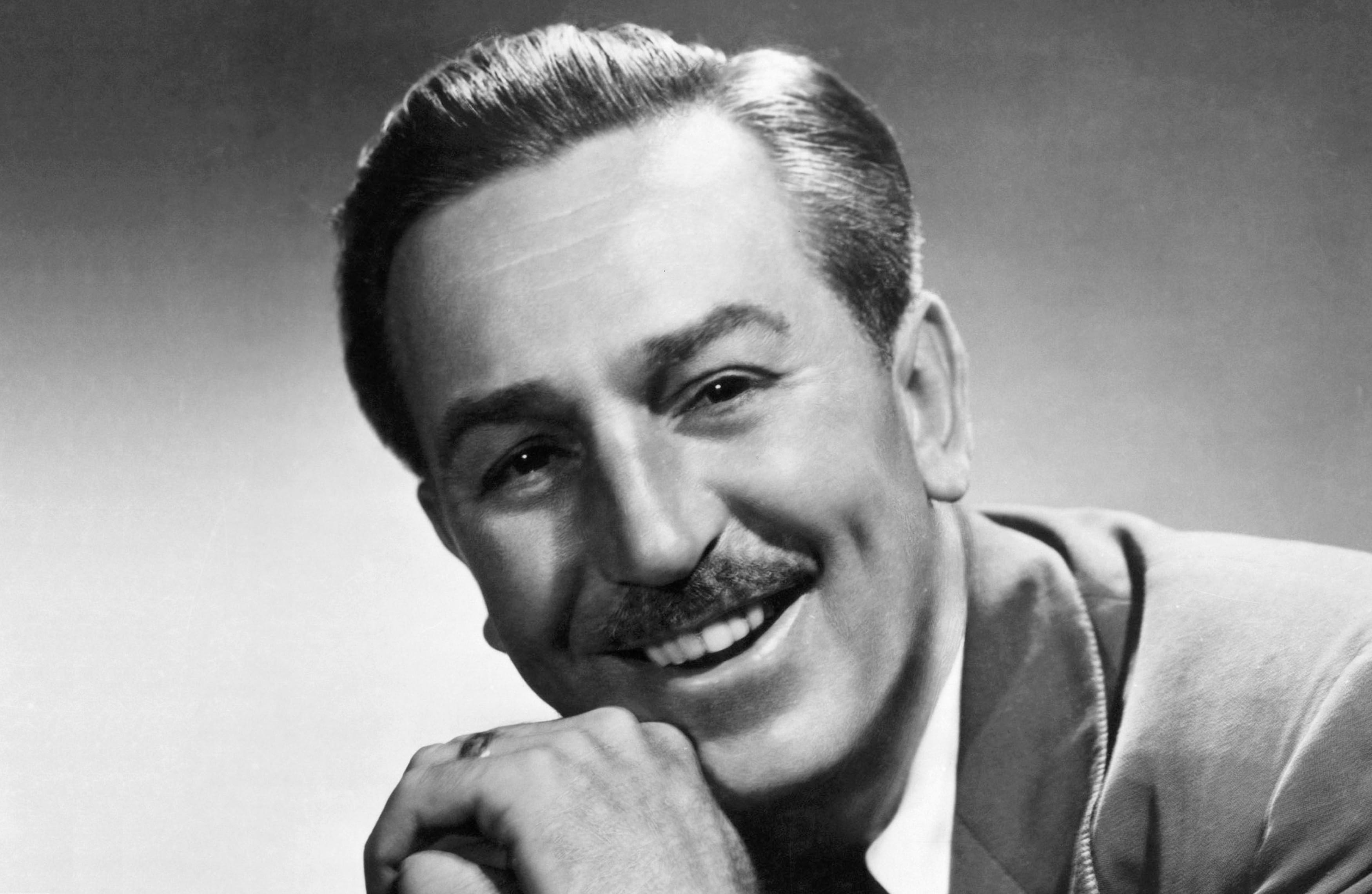
Walter Elias Disney was born in Chicago in 1901. He was the fourth of five children, and as a child developed a keen interest in art and drawing. After being rejected from the US Army for serving in the Great War – he was too young – the 17-year-old Disney forged a birth certificate and joined the Red Cross. While he arrived in France in November 1918, just after the armistice had been declared, he continued to work there for 11 months. During that time some of his illustrations and cartoons were published in the US Army newspaper Stars and Stripes.
In October 1919 Disney returned home to America, taking up an apprenticeship at the Pesmen-Rubin Commercial Art Studio in Kansas City, Missouri.
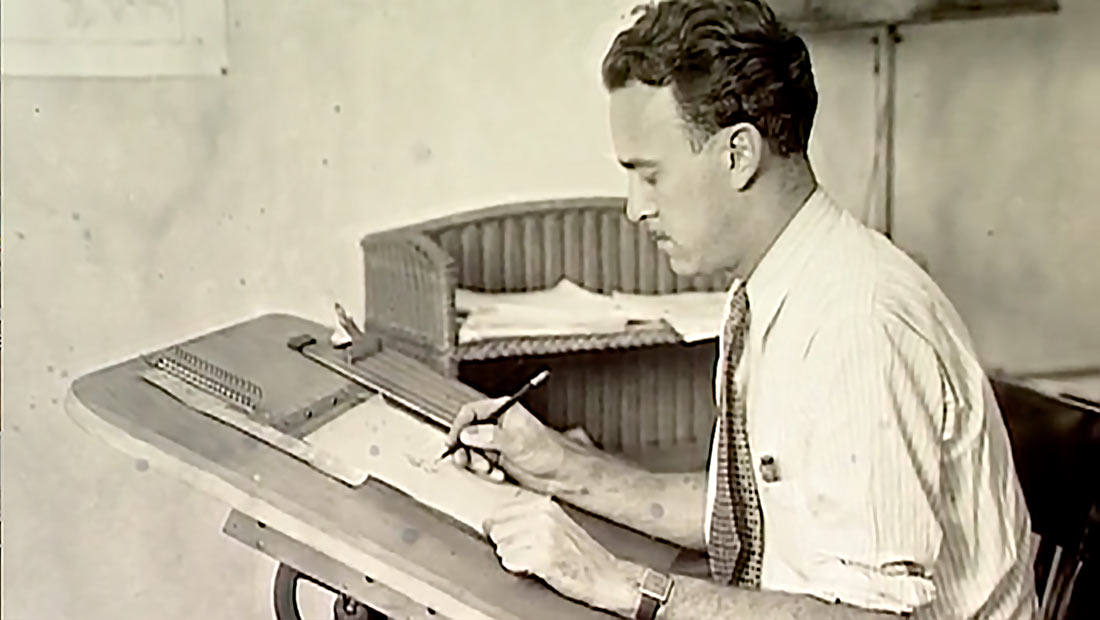
Ubbe Ert Iwerks was born in Kansas City, just a few months before Disney was born in Chicago. He was the son of a German barber, who had philandered his way through multiple wives before abandoning Ubbe’s mother when he was just a teenager. Forced to leave school to work and support his mother, Iwerks eventually found success as a commercial artist and chose to shorten his given name to the simpler Ub. He took up an apprenticeship at Pesmen-Rubin, where he met and befriended fellow apprentice Walt Disney.
It did not take Iwerks and Disney long to form their own commercial partnership, providing assets for the Kansas City Slide Newspaper Company (later the Kansas City Film Ad Company). It was while working for the company that Disney decided to try his hand in the nascent American animation industry.
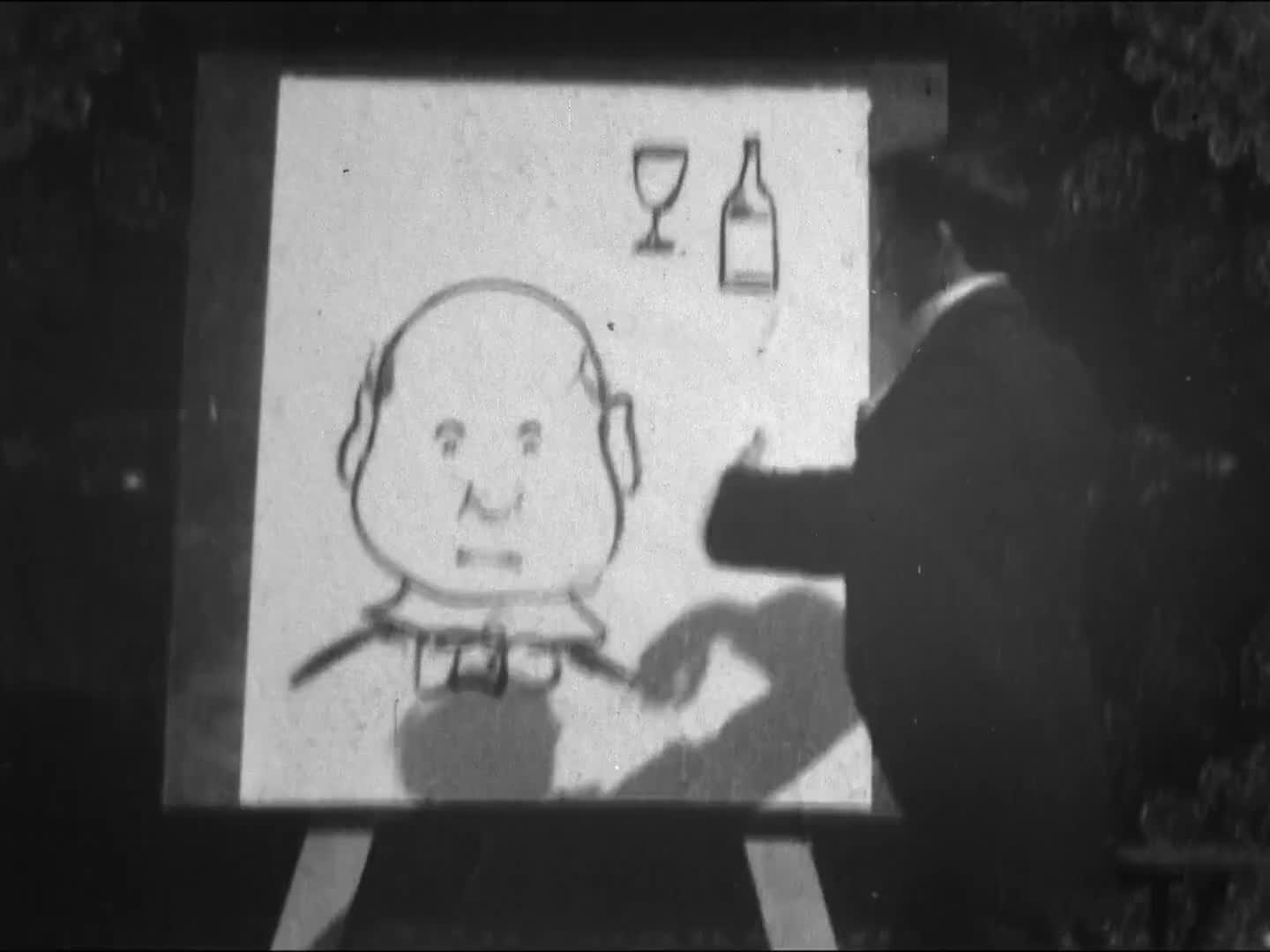
American animation is generally agreed to have started with J. Stuart Blackton’s shorts The Enchanted Drawing (1900) and Humorous Phases of Funny Faces (1906). Early innovators in the industry included Windsor McCay, whose intricately hand-drawn animations included the likes of Little Nemo (1911) and Gertie the Dinosaur (1916). In 1913 Canadian Raoul Barré invented the peg system that allowed artists to better align their drawings from one frame to another. In 1914 John Bray patented the technique of painting animation art onto transparent sheets of celluloid, which allowed animators to draw backgrounds once and only draw every frame for any moving objects in the picture. The new process effectively enabled cost-effective hand-drawn animation to be produced at scale, and led to the industrial production of short animations for movie theatres. From 1916 production companies started producing multiple shorts featuring the same characters. Anthropomorphic animals proved particularly popular, including Krazy Kat (from 1916) and Felix the Cat (1919).
In 1921 Walt Disney set up a business in partnership with older brother Roy, with the intention to make their own animated short films. The Laugh-O-Gram Studio produced a number of silent animated shorts, of which only some have survived to the present day. Walt Disney’s first fully animated short film was 1922’s Little Red Riding Hood, which included (but did not yet name) a Felix-like character named Julius the Cat. While the studio produced 11 shorts – some animated, some live-action, it was their final work that was the most significant.
In the silent short Alice’s Wonderland (1923), a young woman (played by Virginia Davis) visits an animation studio and meets the various people working there. That night she dreams of entering the animated world herself. Alice’s Wonderland, which comprised a blend of live-action and animation, was never screened theatrically but was instead produced to sell a series of Alice shorts to potential distributors. Walt Disney directed and produced the film, and co-wrote it with Hugh Harman and Rudolph Ising – who would later create the Warner Bros Looney Tunes and Merrie Melodies series of shorts. Animating the film were Iwerks and Ising, along with Carman Maxwell and 18-year-old Isadore “Friz” Freling. While all four animators would continue to work for a number of studios, it is worth highlighting Freling in particular. He would eventually work for Harman and Ising at Warner Bros, and direct more of the studio’s animated shorts than anyone else – creating Porky Pig, Sylvester the Cat, and Yosemite Sam in the process.
Alice’s Wonderland came too late to save the Laugh-O-Gram Studio from bankruptcy, but Disney was able to travel to Los Angeles and sell a series of Alice shorts to Winkler Pictures (owned by Margaret Winkler, the world’s first female animation producer, and Charles Mintz). To produce the films Walt and Roy Disney formed a new company, which they called the Disney Brothers Cartoon Studio. In 2023 the studio they founded celebrated its 100th anniversary as the Walt Disney Company.
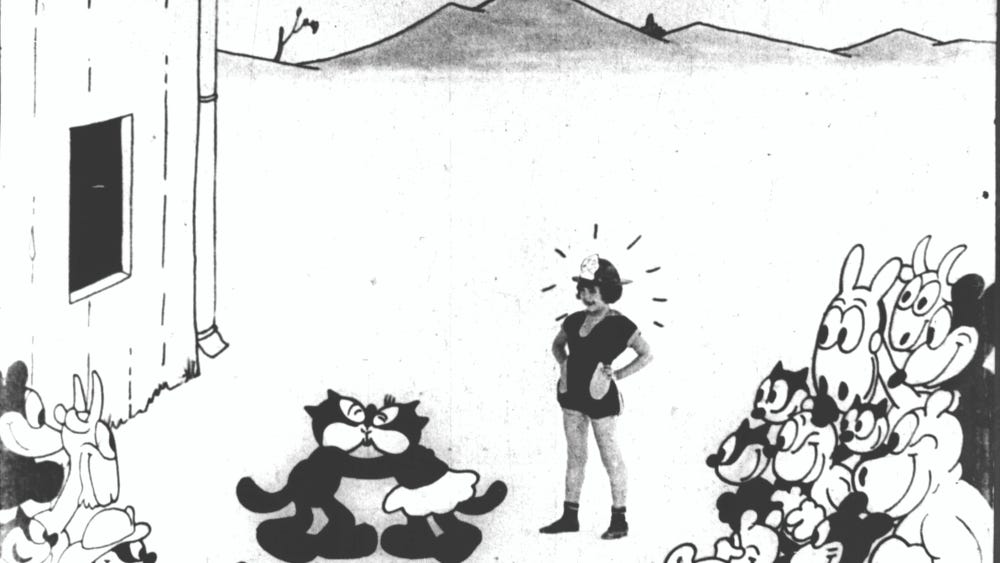
Walt Disney directed and produced a total of 57 Alice comedies between 1923 and 1927. That year he contracted with Universal Pictures via Winkler and Mintz to produce a series of animated comedy shorts featuring his second animal character Oswald the Lucky Rabbit. They proved a major commercial hit for Universal, guaranteeing the Disney brothers an ongoing revenue stream to further establish and expand their studio. With the American economy struggling – the Great Depression would hit a year later – Disney was confronted with a 20% cut in fees from Universal per cartoon, and the realisation that Charles Mintz was progressively poaching artist talent from Disney Brothers to his own company. Incensed, he broke from Winkler Pictures and abandoned the Oswald characters. Disney directed 27 Oswald cartoons in total. Without him, Winkler Pictures would self-produce another 25 between 1928 and 1929. An additional 138 would be produced before the character was retired in 1938. In 2006, as part of an asset exchange with Universal Pictures, the Walt Disney Company acquired all rights to Oswald the Lucky Rabbit to bring it under the company’s ownership for the first time.
In the wake of the Oswald debacle, Walt Disney resolved to create a replacement animated character and to ensure that he retained all rights to them. He named that character Mickey Mouse.
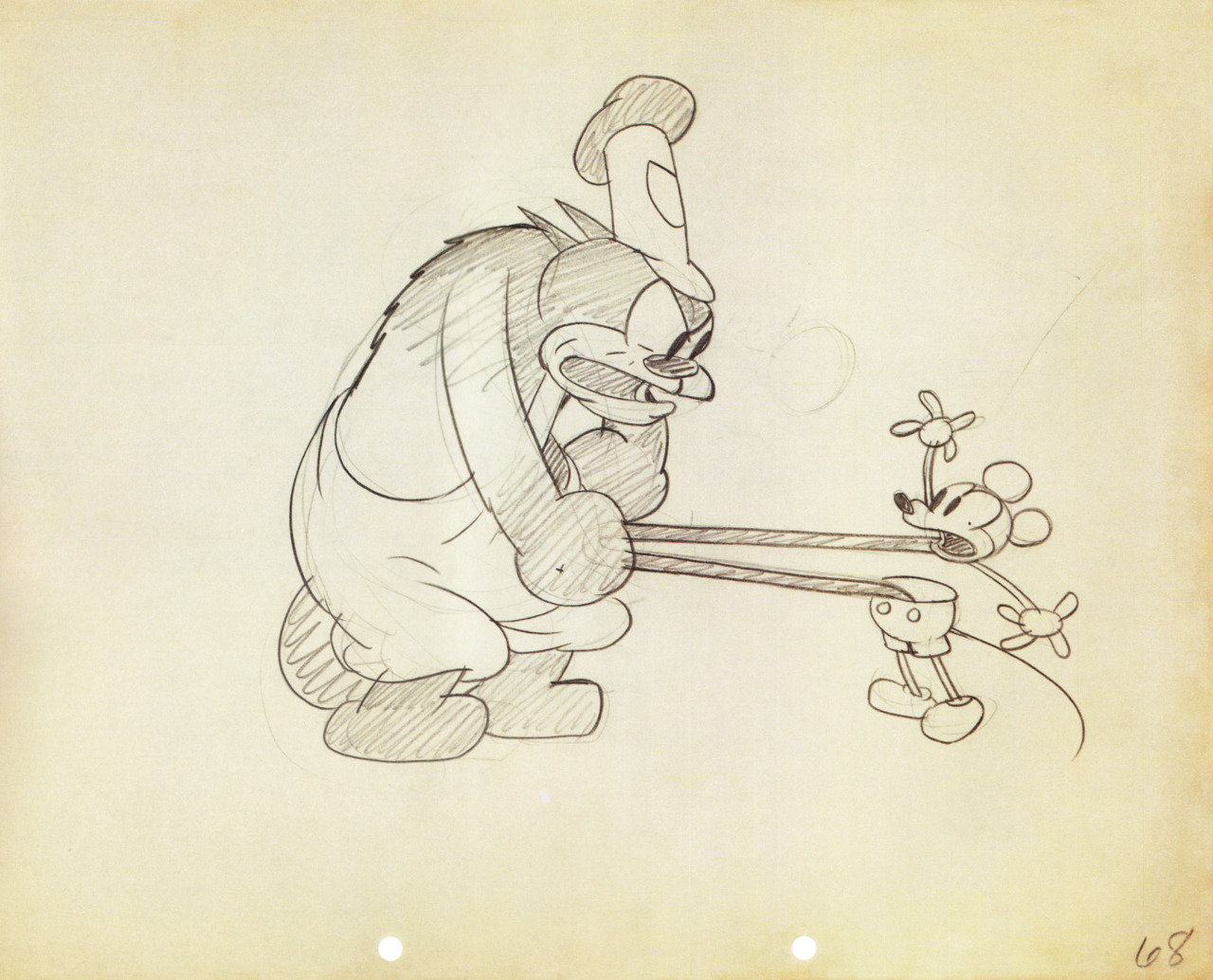
The precise origins of Mickey Mouse – who created what part, who invented his overall design, and even how he was named – are not entirely clear, and subsequent claims and counter-claims over the following decades have not helped matters. It is safe to say that Mickey’s creation was a collaborative process, primarily between Walt Disney and Ub Iwerks, but even between just those two men there are disagreements over who was responsible for what. This is not surprising, or even unusual. The character was invented purely to feature in an animated film, and it seems extremely unlikely that anybody would have anticipated Mickey’s runaway future success.
Before settling on a mouse, Disney had Iwerks sketch a number of other anthropomorphic animals including a horse, a cow, and a frog. It is impossible not to notice that Mickey closely resembles Oswald the Lucky Rabbit, spare the addition of circular ears. Disney originally named the character Mortimer Mouse; this was allegedly changed to Mickey at his wife’s suggestion.
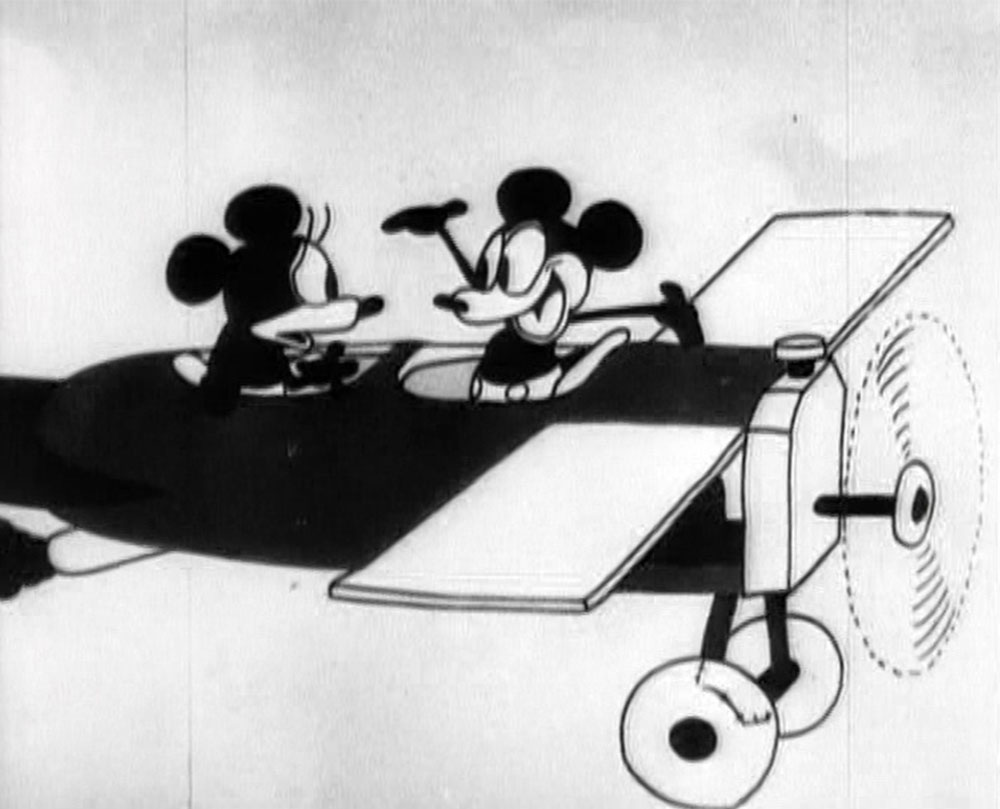
Disney and Iwerks co-directed a test short for the character, titled Plane Crazy. The silent film ran just shy of six minutes, and saw Mickey take to the skies in an aeroplane. Plane Crazy received a test screening on 15 May 1928, intended to both road-test tMickey with audiences and to hopefully attract a studio buyer. When it failed to secure one, it was shelved in favour of a second pilot project: The Gallopin’ Gaucho. Again the short was co-directed by Disney and Iwerks and featured Mickey Mouse in the lead, and again it failed to stimulate studio interest.
For the third attempt, titled Steamboat Willie, Walt Disney was keen to produce the film with synchronised sound – which had been introduced to Hollywood via 1927’s The Jazz Singer. Production ran from July to September 1928, with an initial private screening arranged in late July using early animated sequences and the music and sound effects performed live. ‘The effect on our little audience was nothing less than electric,’ Disney would later recall. ‘They responded almost instinctively to this union of sound and motion. I thought they were kidding me. So they put me in the audience and ran the action again. It was terrible, but it was wonderful! And it was something new!’[2]
The clear merit of synchronising sound to Steamboat Willie led Disney to immediately retro-fit the earlier Mickey Mouse shorts with musical scores as well. While Steamboat Willie had used pre-existing music conducted by Carl Edouarde, it was decided the other two shorts would need original music composed for them. It was his need for a composer that brought Walt Disney to Carl Stalling’s door.
Steamboat Willie premiered in New York in November 1928, attached to the independent feature Gang War. While the feature was soon forgotten, the short was an immediate hit with audiences and critics. Variety claimed ‘this one represents a high order of cartoon ingenuity, cleverly combined with sound effects. The union brought forth laughs galore. Giggles came so fast at the Colony they were stumbling over each other. It’s a peach of a synchronization job all the way, bright, snappy, and fits the situation perfectly.’[3]
Disney signed a deal with Pat Power Celebrity Productions for the latter to distribute Steamboat Willie and any subsequent Mickey Mouse shorts.
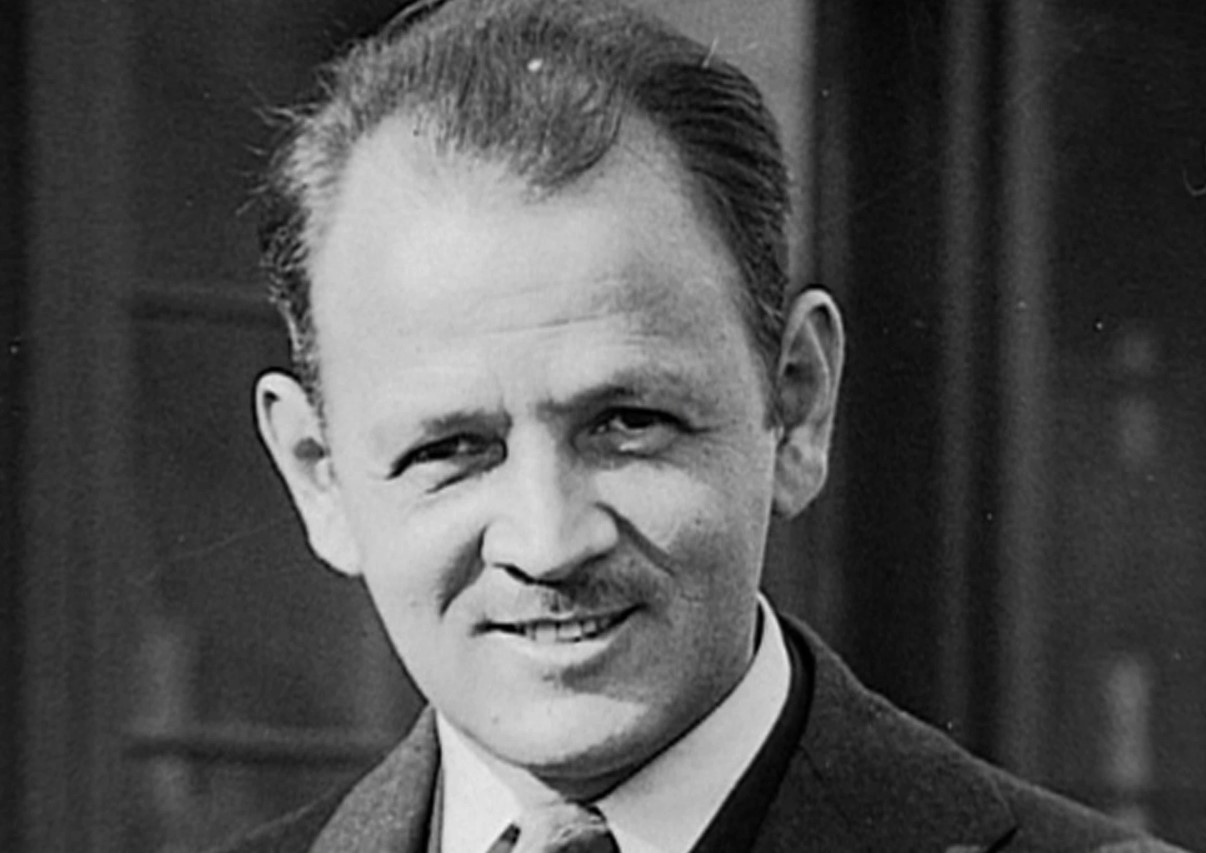
So, to Stalling: Carl William Stalling was born in Missouri in 1891 to German immigrant parents. He started playing the piano at the age of six. By the time he was 12 he was playing the piano professionally, accompanying the action on local silent film screenings. His career as a piano accompanist took him to Kansas City and the Isis Movie Theatre, which is where he first met Walt Disney in the early 1920s.
Disney clearly remembered their first encounter, because in September 1928 he returned to Kansas City to offer Stalling the chance to retrofit musical scores to Plane Crazy and The Gallopin’ Gaucho. Stalling was particularly impressed with what Disney and Iwerks had done in terms of synchronising sound and vision in Steamboat Willie, and keen to apply his musical talents to scoring rather than simply playing accompanying tunes live in the theatre. It helped that the offer also included a studio appointment as musical director – provided Stalling was willing to relocate to Los Angeles.
It was while working on these scores that Stalling began to consider the artistic potential of combining animation to classical music: using pre-existing, popular compositions but allowing the music to inspire original animations at the same time. He called his idea a ‘musical novelty’, and presented the concept to Disney. As a test animation, he suggested using Edvard Grieg’s “March of the Dwarfs” as an accompaniment to a group of dancing skeletons. In a 20 September 1928 letter to Iwerks and his brother Roy, Walt noted the potential of Stalling’s ‘musical novelty’ idea. Three days later, on 23 September, he wrote that ‘Carl’s idea of The Skeleton Dance as a musical novelty has been growing on me. I think it has dandy possibilities.’[4]
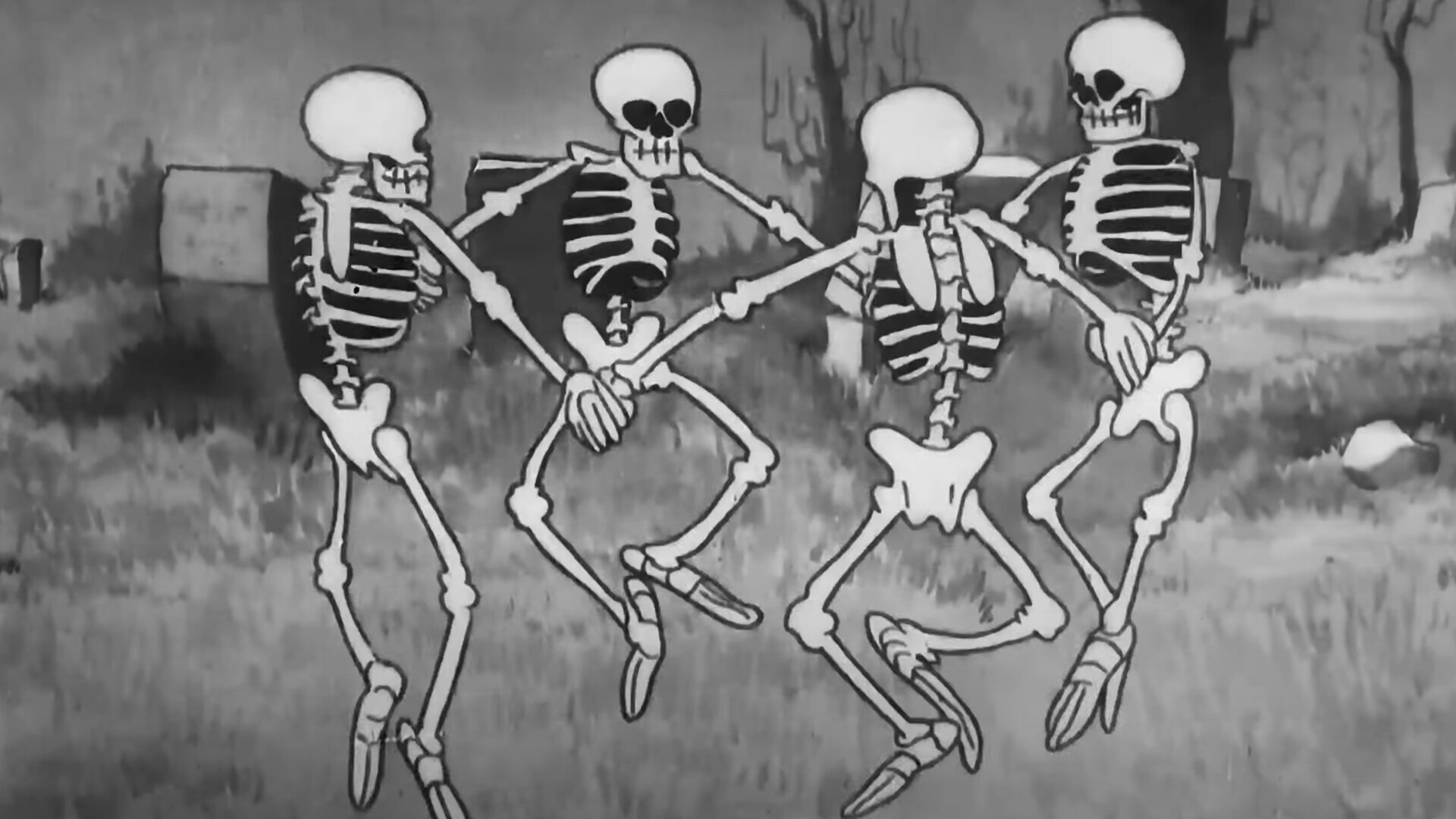
The short went through multiple working titles, including The Spook Dance and Haunted Harmonies, before Disney settled on The Skeleton Dance as a permanent name. It took Iwerks six weeks to animate the short based on Walt Disney’s direction, starting in mid-January 1929 and winding up by the end of February. While Iwerks was reported to have animated the entire short by himself, documented evidence suggests a few key characters were produced by assistants – Les Clark later claimed to have animated one skeleton playing another’s ribs like a xylophone, while animation of a rooster that was re-used in The Cat’s Nightmare (1931) was later credited to Wilfred Jackson. While Iwerks animated based on a temporary musical track by Stalling, the full score was recorded in New York in the last two weeks of February.
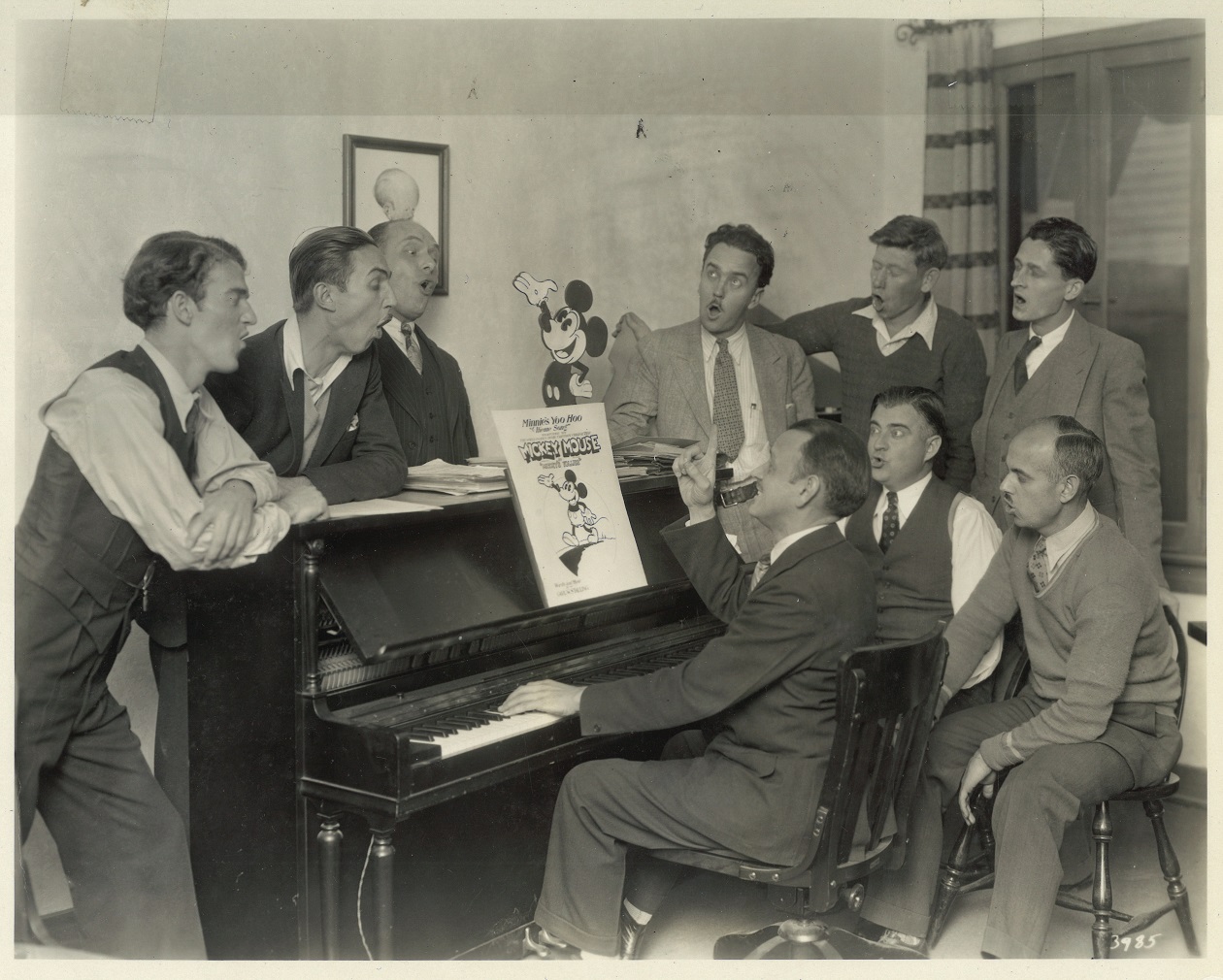
The Skeleton Dance was far from the first animated short to be accompanied by music. Stalling’s innovation was to draw upon established classical music – in this case not only Grieg’s “March of the Dwarfs” but Camille Saint-Saëns’ “Danse Macabre” – and develop them into a combined pastiche. It was a technique that served Stalling well; it not only formed the musical identity of the Silly Symphonies series of shorts, but ensured the commercial and critical success of Stalling’s later work on Warner Bros’ Looney Tunes and Merrie Melodies.
It is thanks to Carl Stalling’s musical innovations that more than one generation of filmgoers worldwide first experienced the great works of classical music, popular folk songs, and opera. While it is his later work scoring for Warner Bros that had the greatest effect (notably The Rabbit of Seville), it is unlikely those films would not have existed without the foundational work of The Skeleton Dance and other early Silly Symphonies.
It is arguable that Stalling’s re-arrangements of pre-existing melodies, and the combination of more than one into a soundtrack, mark a prototypical example of ‘remix culture’. By taking individual compositions and applying them to Disney and Iwerks’ animation, he is re-appropriating those works and transforming their meanings. Perhaps the pinnacle of the transformational effect animation had on classical music was Disney’s 1940 production Fantasia, which provided animated sequences set to a variety of classical music directed by Walt’s studio animators. There has been debate over the decades over whether these kinds of animated adaptations of classical music have had a negative effect, by implanting a predominant image in the minds of listeners. It is difficult, for example, to hear Paul Dukas’ “The Sorcerer’s Apprentice: and not immediately think of Mickey Mouse in a red robe and pointed hat. Similarly, about as many people, upon hearing Rossini’s “The Barber of Seville”, will think of Bugs Bunny and Elmer Fudd as do the original Italian opera. If such an effect does exist – and I think it does – surely it is as much testament to the popular appeal of such adaptations as anything else.
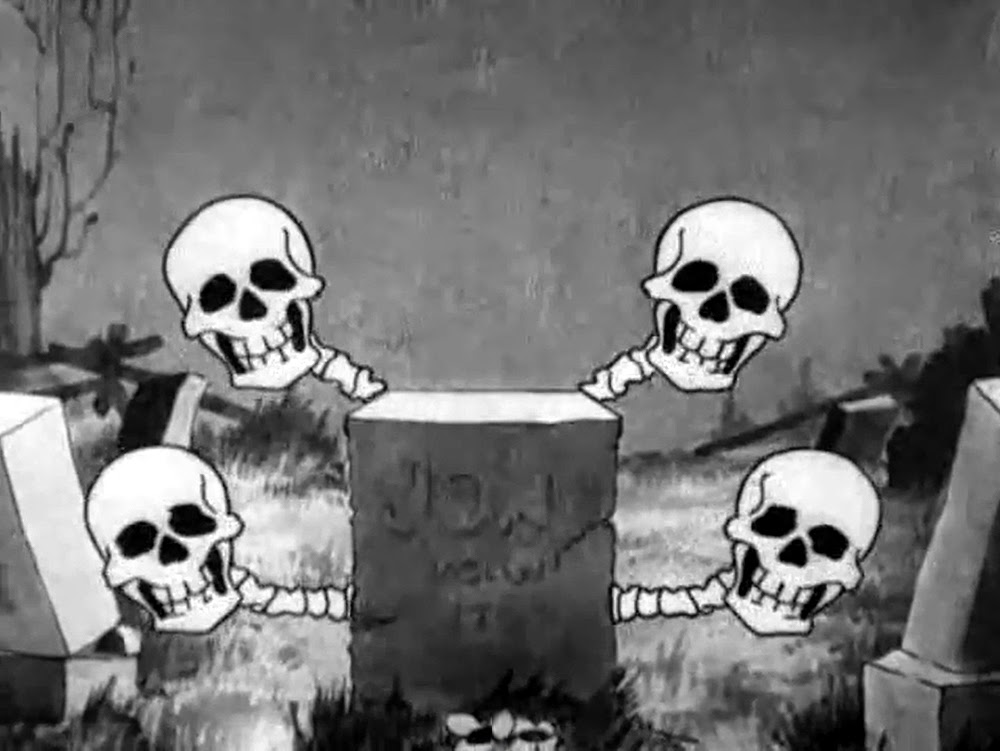
One of the key technical innovations that Ub Iwerks brought to The Skeleton Dance was an unprecedented ability to align animated movement to key musical beats. Key physical movements by the skeletons – the full extent of a kick, or the precise frame where a foot would step on the ground – were matched precisely to specific musical notes. It marked a huge advance in the overall realism of the animated image, better resembling human dance and also emphasising the rhythm. Subsequent Silly Symphonies would benefit from additional techniques developed by animator Wilfred Jackson: carefully notated plotting of key animated frames not only to equivalent melodic beats but also backbeats and more complex syncopation.
Iwerks was a credited director of four Silly Symphonies before leaving Walt Disney Productions. Wilfred Jackson was credited with 31, including The Ugly Duckling (1931), Santa’s Workshop (1932), The Grasshopper and the Ants (1934), The Wise Little Hen (featuring Donald Duck’s first appearance, 1934), plus Oscar-winners The Tortoise and the Hare (1935) and The Old Mill (1937). From 1937 Jackson shifted to Disney’s feature productions, working as sequence director and later overall director of Snow White and the Seven Dwarfs, Pinocchio, Dumbo, Cinderella, Alice in Wonderland, and others.
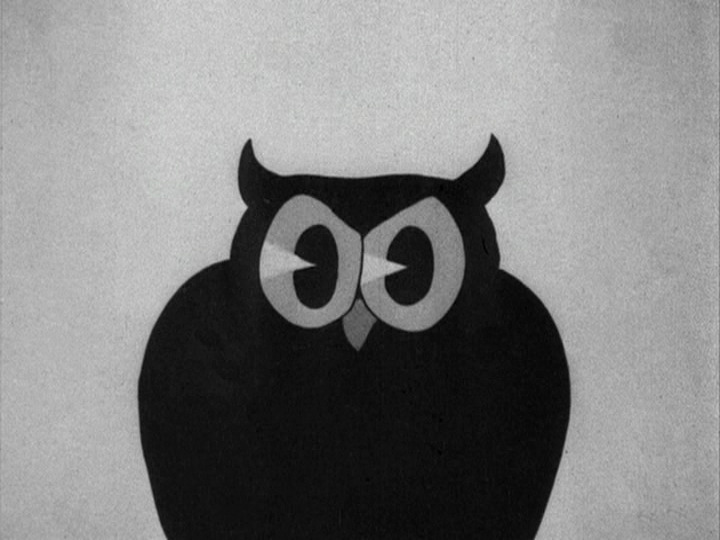
The short begins with lightning flashes – including momentary frames of black and white to accentuate the effect. An owl appears in close-up, the picture pulling back to reveal the whole body silhouetted by the moon. A fierce wind blows, ruffling the owl’s feathers. A branch startles it, flailing in the wind like a snatching hand. Oswald the Lucky Rabbit this is not.
A church bell rings, disturbing a flock of bats that flies into the sky. A large spider scuttles for cover. A dog howls at the moon. In the church cemetery, a pair of black cats yowl angrily at one another, until disturbed by an animated skeleton rising from the dead. The skeleton leaps on top of a tombstone in a beast-like fashion. From there, it lunges towards the audience.
The cats are openly comedic. Everything else is not. It may seem primitive by 21st century standards, but Variety really did warn its readers not to take their children to see it. In 1931 the short was banned by the Danish government for its macabre imagery. It is only once the skeleton is joined by three of its brethren that the short transforms into an amusing, albeit still rather creepy, dance routine.
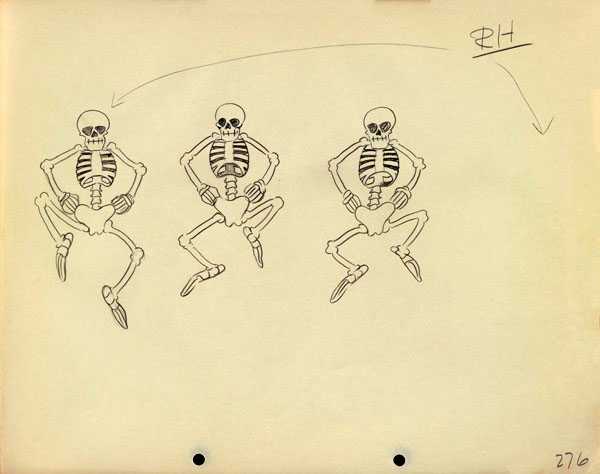
The Skeleton Dance was completed at a reported total cost of $5,485. It then took Walt Disney several months to find a movie theatre interested enough to screen it. The short ultimately made its Los Angeles premiere in June, attached to a print of F.W. Murnau’s Four Devils. At the time of The Skeleton Dance’s release, all of Disney’s animated films – including the popular Mickey Mouse shorts – were distributed to American theatres by Pat Power Celebrity Productions. Based on the success of The Skeleton Dance, subsequent Silly Symphonies were distributed under a separate contract with Columbia Pictures. This gave the new range of films guaranteed national distribution, as opposed to the more uneven distribution under Powers. Both companies remained linked, however, with Disney still relying on Pat Powers’ New York recording studio for the Symphonies soundtracks. When the dual coast production schedule proved cumbersome – animation in the west, music in the east, Disney arranged with Powers to set up a mobile sound recording studio in Los Angeles.
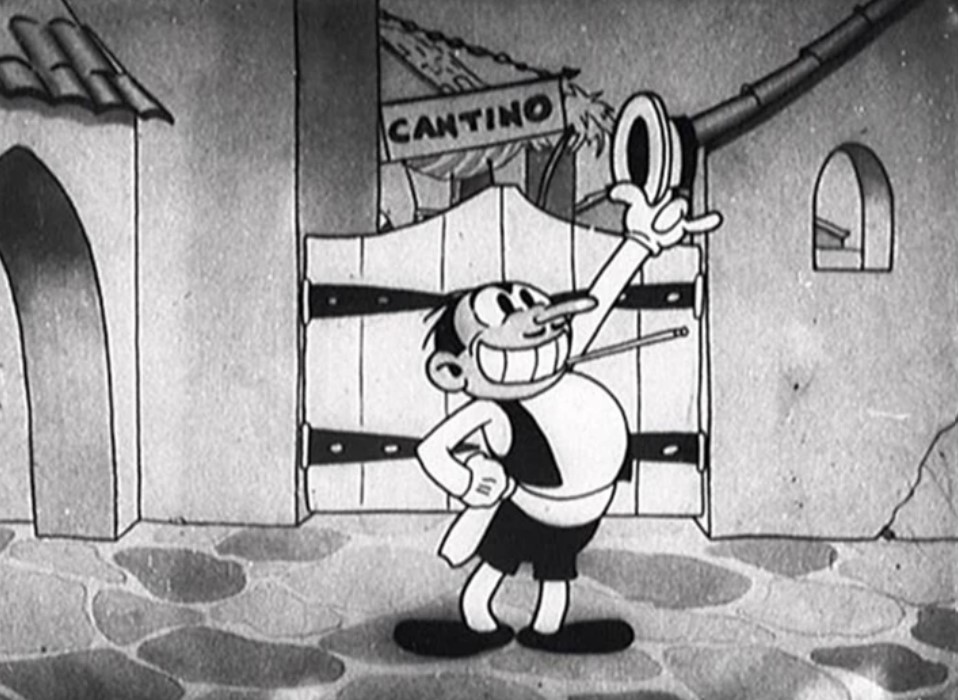
The second Silly Symphony, El Terrible Toreador, was released in September 1929. Direction was credited to Walt Disney, but as would be the growing case there was some debate over how much of Iwerks’ animation was based on Disney’s instruction, and how much on his own. Stalling’s score lifted predominantly from Bizet’s “Carmen”.
By the end of 1929 there would be another three shorts produced: Springtime (insects, birds, and frogs dance to music by Grieg, Von Blon, and Offenbach), Hell’s Bells (demons rebel against Satan to music by Grieg – again, Gounod, and Mendelssohn), and The Merry Dwarfs (a drunken dance set to Verdi).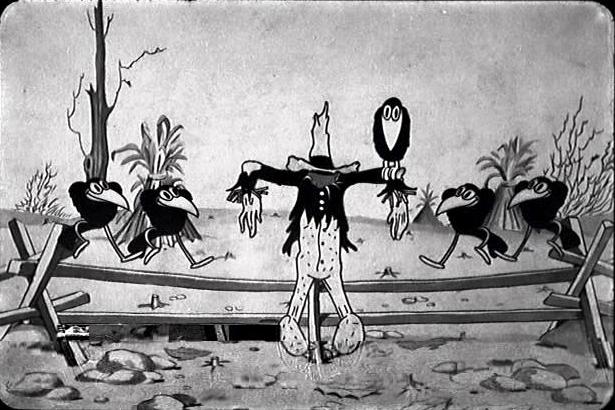
Disney and Iwerks’ partnership did not survive much longer. In 1930, chafing under Disney’s leadership and demands – and believing his contributions to the cartoons’ success were going unacknowledged – Iwerks signed a contract with Pat Powers to set up his own animation company. His final animation work for Disney was on the Silly Symphonies short Autumn (1930).
Much to Walt and Roy Disney’s dismay, Powers poached Carl Stalling as his own musical director at the same time. Concerns that the loss of both key foundational figures at once raised concerns there would be delays in the Disney production schedule, however the raising of skilled junior staff to key roles partially alleviated the problem. In addition to Wilfred Jackson, junior animators including Burt Gillett, David Hand, and Ben Sharpsteen were provided the opportunity to hone their craft and direct a range of popular works. Gillett would win Oscars for Flowers and Trees (1932) and Three Little Pigs (1933) before moving to the Van Beuren animation studio. Hand was later supervising director of Snow White and the Seven Dwarfs and Bambi. Sharpsteen would direct a number of Walt Disney Productions nature documentaries.
Walt Disney used Stalling’s departure to shake up the music content of the Silly Symphonies. Replacement composers Frank Churchill and Lee Harline were encouraged to replace Stalling’s pastiches of pre-existing music with their own original compositions. Not only did the shift save on licensing pre-existing music, it allowed a stronger creative expression for each short. The introduction of original music and songs also kickstarted the Disney influence on popular music as well as animation. Churchill’s “Who’s Afraid of the Big Bad Wolf?”, written for Three Little Pigs, became a huge commercial hit outside of its cartoon origins, and was the first in an ongoing legacy of popular Disney songs that continues well into the current century. Breaking the existing relationship with Pat Powers also allowed Disney to replace Power’s own Cinephone sound technology with the technically superior RCA Photophone.
In 1932 Walt Disney Productions exited its distribution arrangement with Columbia in favour of United Artists, based in part on the effort of UA co-founder Mary Pickford. The new partnership also heralded a shift into three-strip Technicolor. Walt had considered animating in colour as early as 1926, but had been unimpressed with the technology of the time.
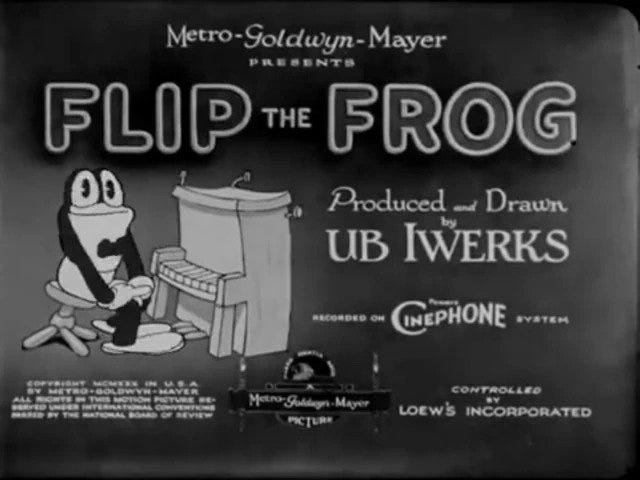
The Iwerks Studio spent most of its early years producing animated shorts for MGM, featuring Iwerks’ own animal character Flip the Frog. One of Iwerks’ employees during this time, Fred Kopietz, recommended he hire a friend of his: a recent Chouinard Art Institute graduate named Charles M. “Chuck” Jones. It was a modest entry into the animation industry for a man later to become an Oscar-winning legend named by Robin Williams as ‘the Orson Welles of animation’.
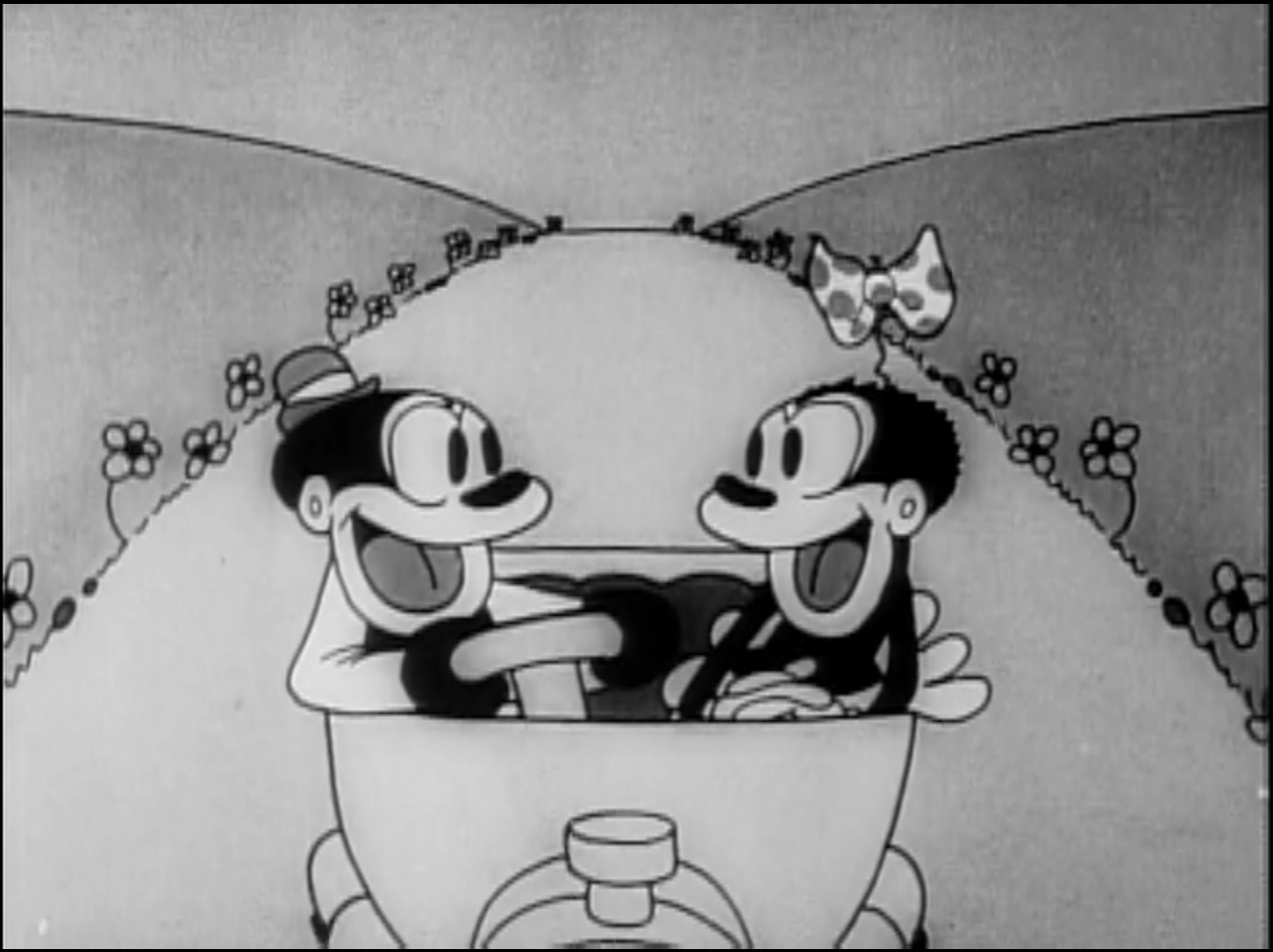
The overwhelming success of the Silly Symphonies inevitably led to copycat and competing productions. In April 1930 Warner Bros released “Sinkin’ in the Bathtub”, the first in their Looney Tunes series of shorts – so-named to directly reference the Silly Symphonies. In August 1931 the studio launched their Merrie Melodies range, which specifically used and promoted their own catalogue of songs, with the short “Lady, Play Your Mandolin”. At the time of writing, Warner Bros has produced more than 1,040 animated films between the two labels.
When Walt Disney Productions shifted distribution from Columbia to United Artists, the former contracted Charles Mintz’s Screen Gems to produce the Color Rhapsodies: animated musical shorts produced in two-strip Technicolor (Disney held the exclusive right to animate with the three-strip process). 119 shorts were produced between 1934 and 1949, directed by a range of artists including Ub Iwerks. One of Iwerks’ films was a revised version of The Skeleton Dance, this time in full colour and retitled The Skeleton Frolic.
Between 1934 and 1938 MGM distributed 37 animated shorts under the Happy Harmonies banner. While the shorts are generally not well-remembered, they did provide a directorial debut in 1936 for William Hanna, later to partner with Joseph Barbera in creating Tom & Jerry, The Flintstones, Huckleberry Hound, The Jetsons, and Scooby-Doo.
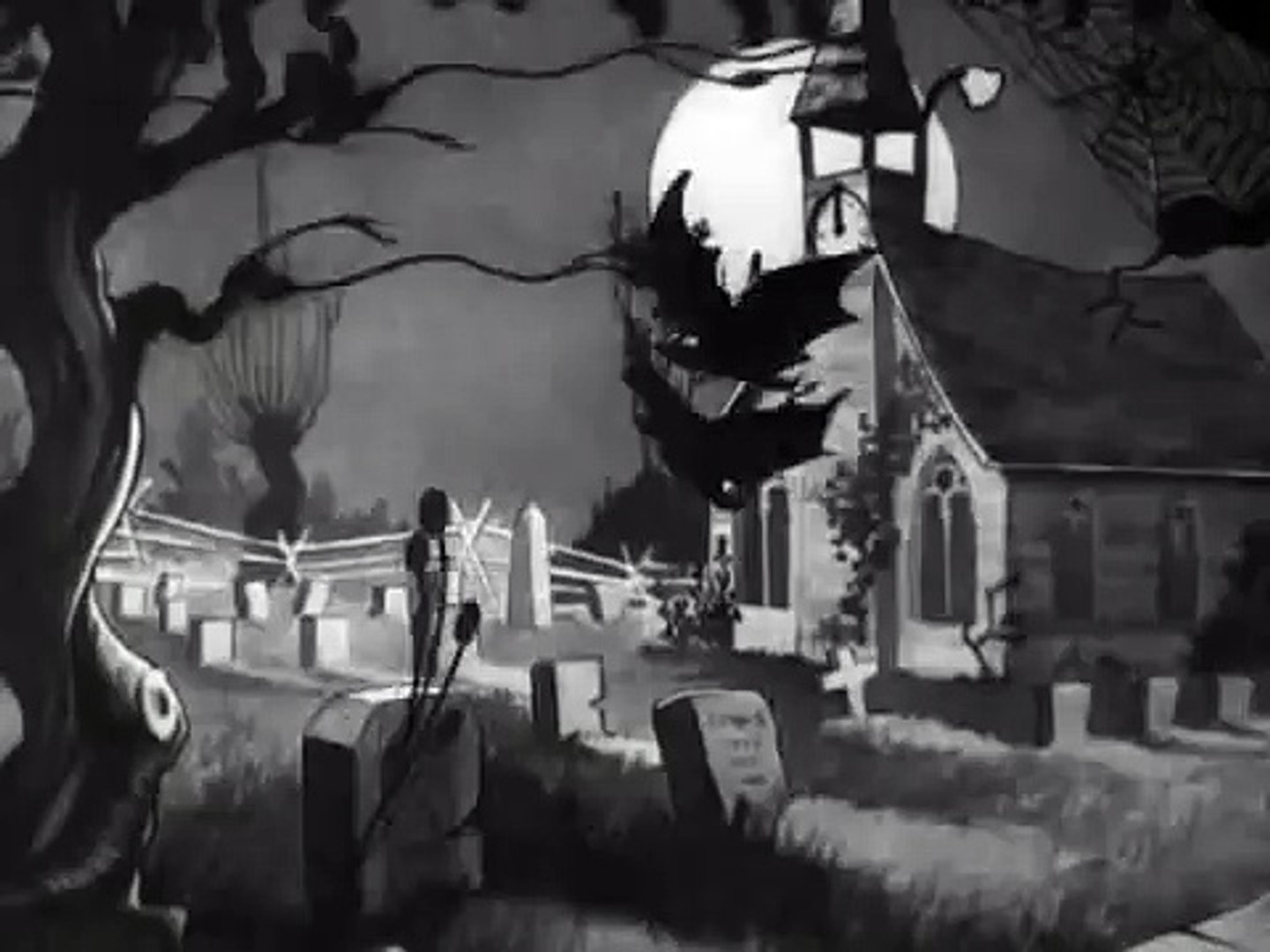
With its entry into the public domain, The Skeleton Dance now becomes available to anybody and everybody to reproduce, to adapt, to share, and to remix. Its influence on American animation, however, is already a matter for the public record.
From its success followed literally thousands of animated shorts, each with a strong relationship to music and a combined language of images and sounds to emphasise comedy and drama in them all.
From the junior animators that learned their craft under Iwerks came multiple generations of outstanding animated features – both at Disney and at rival studios that poached Disney’s and fostered their own similar talent.
It was the first Disney production to toy seriously with horror imagery. That slightly adult, someone creepy edge never left the company. It echoes in the witch’s transformation in Snow White, the death of Bambi’s mother, and the Headless Horseman’s ride in The Tale of Ichabod and Mr Toad.
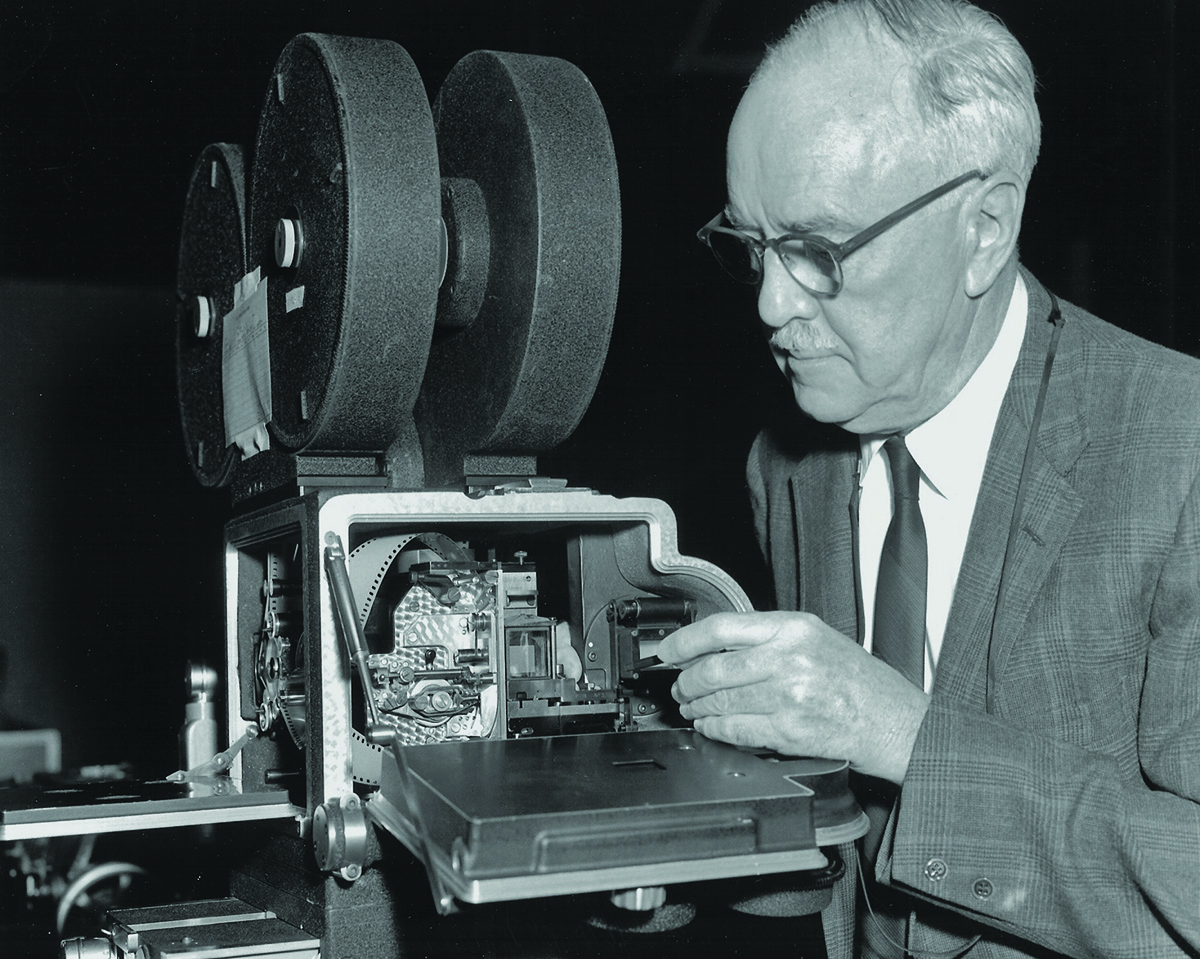
When Ub Iwerks returned to Walt Disney Productions in 1940 it was not as an animator but as an innovator and visual effects specialist, developing such techniques as using photocopiers accelerate hand-drawn animation from One Hundred and One Dalmatians (1961) and combining live-action and animated footage in Song of the South (1946) and Mary Poppins (1964). Iwerks received two Oscars for his visual effects work, and was nominated for a third for his work on Alfred Hitchcock’s The Birds (1963).
Carl Stalling eventually retired from Warner Bros in 1958, having been credited on a jaw-dropping 600 animated short films.
Of the three Walt Disney remains the most famous. He died in 1966, the recipient of a record-breaking 22 Academy Awards from 59 nominations. In 2023 the company that he founded reported revenue of almost US$89 billion from its films and television programs, licensing and merchandise, videogames, media networks, parks, and resorts.
The Skeleton Dance may be a brief confection, but it was significant and influential. Indeed, it was revolutionary. Now, 95 years on, and it can now belong to everybody.
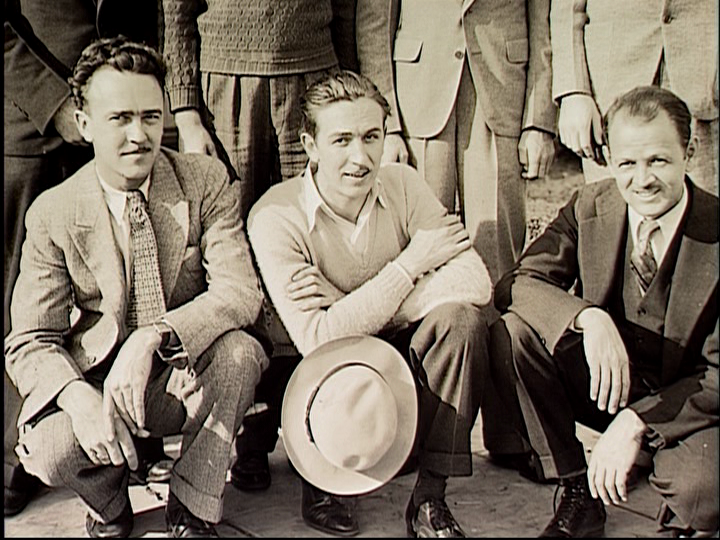
[1] Quoted in “Talking Shorts”, Variety, July 17 1929.
[2] Leonard Martin, Of Mice and Magic: A History of American Animated Cartoons, New American Library, 1987.
[3] Quoted in “Talking Shorts”, Variety, 21 November 1928.
[4] Russell Merritt and J.B. Kaufman, Walt Disney’s Silly Symphonies: A Companion to the Classic Cartoon Series, University of California, 2006.
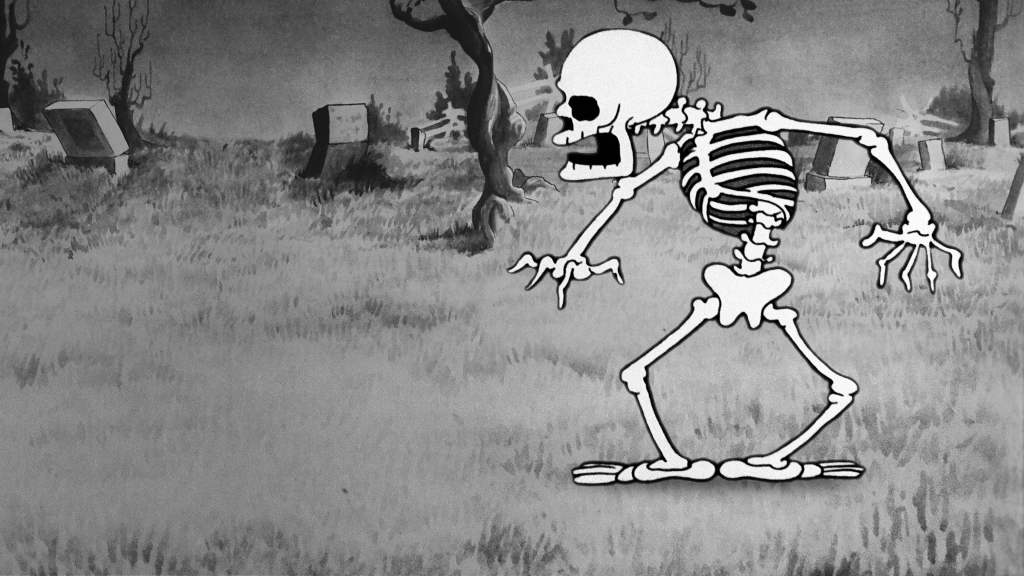
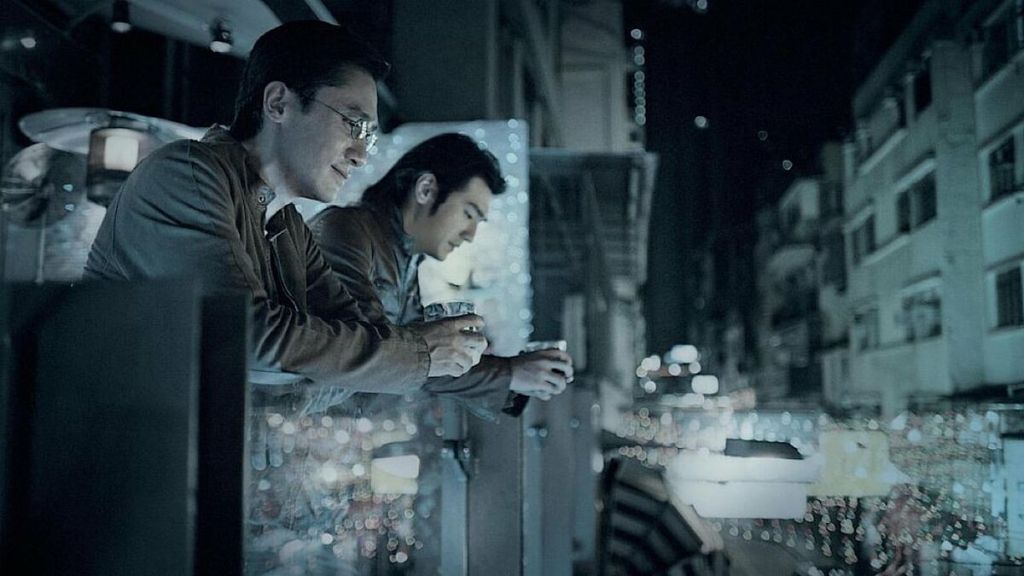
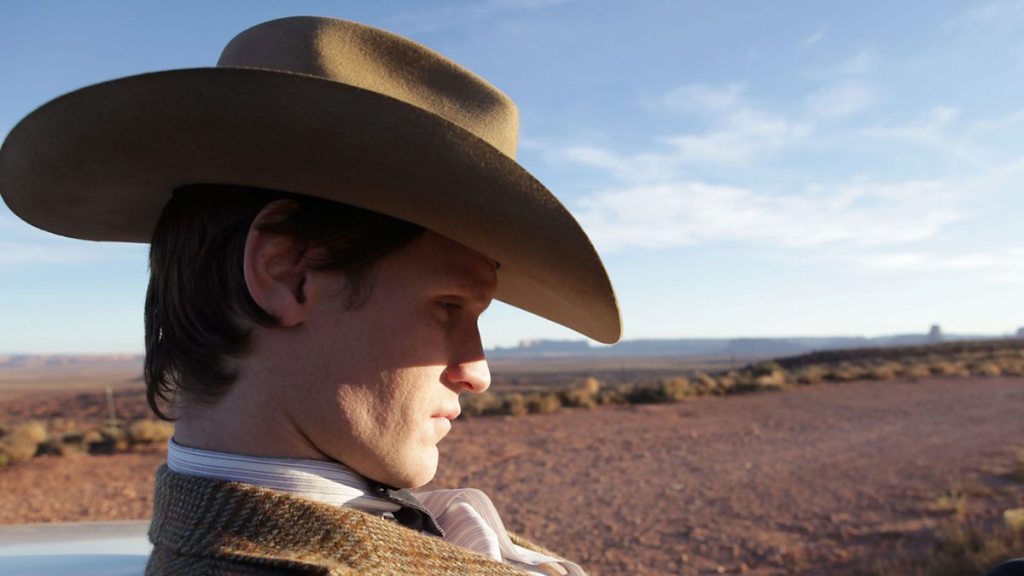
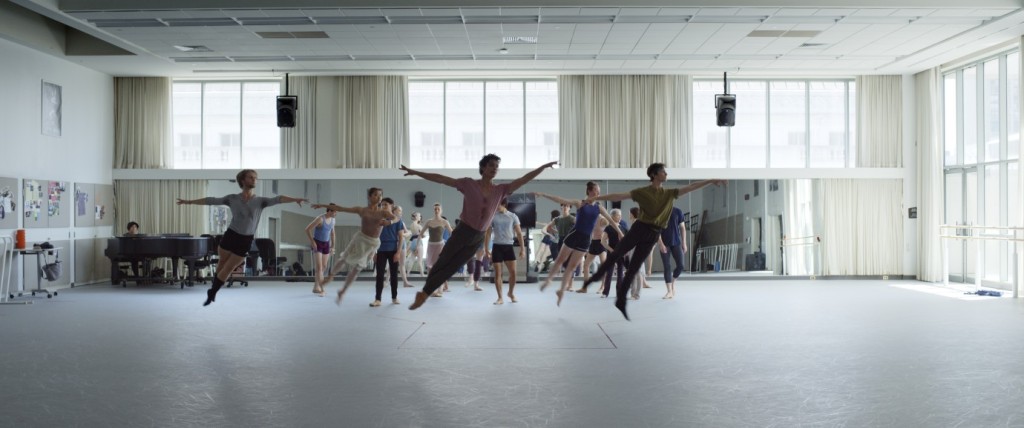
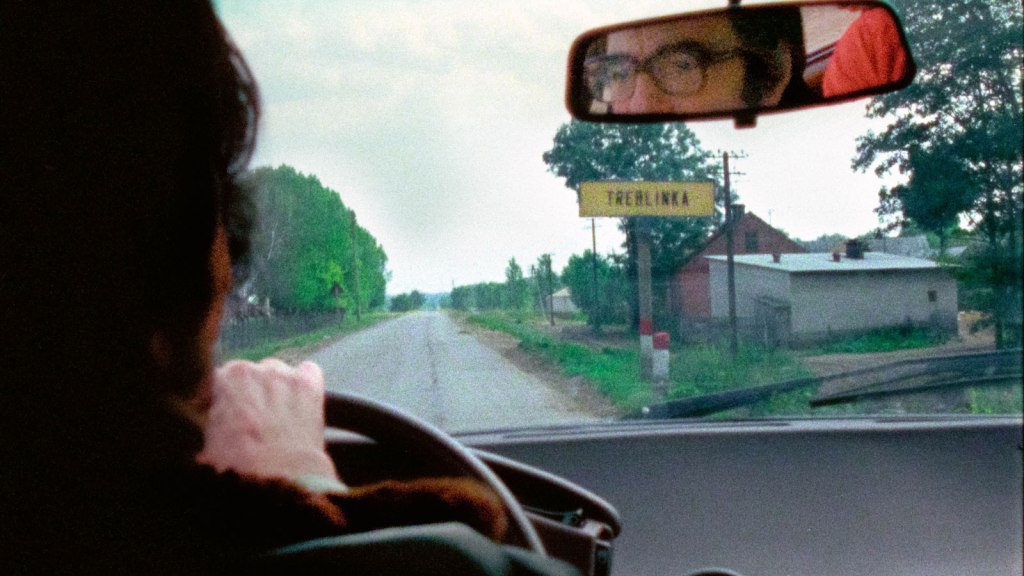
Leave a comment